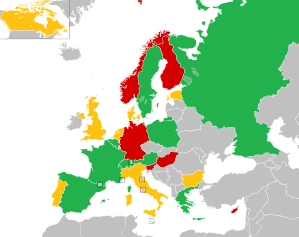Eurovision Young Dancers 1995
| Eurovision Young Dancers 1995 | |
|---|---|
 | |
| Dates | |
| Semi-final | 3 June 1995 |
| Final | 6 June 1995 |
| Host | |
| Venue | Palais de Beaulieu, Lausanne, Switzerland |
| Presenter(s) |
|
| Host broadcaster | Swiss Broadcasting Corporation (SRG SSR) |
| Interval act | "Moments in a garden of Spain": Flamenco show by Nina Corti and her musicians |
| Participants | |
| Number of entries | 15 |
| Debuting countries | |
| Returning countries | None |
| Withdrawing countries | |
|
Participation map
| |
| Vote | |
| Voting system | A professional jury chose the finalists and the top 3 performances |
| Winning dancers |
Jesús Pastor Sauquillo & Ruth Miró Salvador |
The Eurovision Young Dancers 1995 was the sixth edition of the Eurovision Young Dancers, held at the Palais de Beaulieu in Lausanne, Switzerland on 6 June 1995.[1] Organised by the European Broadcasting Union (EBU) and host broadcaster Swiss Broadcasting Corporation (SRG SSR), dancers from nine countries participated in the televised final. A total of fifteen countries took part in the competition. Hungary and Russia made their début while Denmark and Estonia withdrew.[1] However, the Danish broadcaster DR broadcast the event as did Bulgaria and Romania.[1]
The semi-final took place days 3 before the final (3 June 1995). Like in the previous contests, each country could participate with one or two dancers, male or female, not older than 19, that could perform one or two different dances: either a 2 variations (individual) no longer than 5 minutes each or a "pas de deux" (couples) no longer than 10 minutes.[1]
The disqualified countries were, Cyprus, Finland, Germany, Hungary, Norway and Slovenia. Spain, represented by Jesús Pastor Sahuquillo and Ruth Miró Salvador, won the contest for 4th time (3rd in a row) with Sweden and Belgium placing second and third respectively.[2]
Location
.jpg)
Palais de Beaulieu, a convention centre in Lausanne, Switzerland, was the host venue for the 1995 edition of the Eurovision Young Dancers.[1]
The centre includes the Théâtre de Beaulieu concert, dance and theatre hall and hosted the 1989 Eurovision Song Contest. With 1,850 seats, the Théâtre de Beaulieu is the biggest theatre in Switzerland.[3] The Prix de Lausanne, an international ballet competition, is hosted at the centre.
Format
The format consists of dancers who are non-professional and between the ages of 16–21, competing in a performance of dance routines of their choice, which they have prepared in advance of the competition. All of the acts then take part in a choreographed group dance during 'Young Dancers Week'.[4]
Jury members of a professional aspect and representing the elements of ballet, contemporary, and modern dancing styles, score each of the competing individual and group dance routines. Once all the jury votes have been counted, the two participants which received the highest total of points progress to a final round. The final round consists of a 90-second 'dual', were each of the finalists perform a 45-second random dance-off routine. The overall winner upon completion of the final dances is chosen by the professional jury members.[4]
Results
Preliminary round
A total of fifteen countries took part in the preliminary round of the 1995 contest, of which eight qualified to the televised grand final.[1]
| Country | Name | Result |
|---|---|---|
| Janna Eklund | Failed to qualify | |
| Jeroen Hofmans | Qualified | |
| Irina Schlaht | Failed to qualify | |
| Maria Alexandrova | Qualified | |
| Damjan Mohorko | Failed to qualify | |
| Maria Mikalsen | Failed to qualify | |
| Oliver Preiss | Qualified | |
| Franghiskos Toumbakaris | Qualified | |
| Carolina Constadinou | Failed to qualify | |
| Sara Weisz | Failed to qualify | |
| Filip Barankiewicz | Qualified | |
| Anne-Catherine Haller | Qualified | |
| Nadja Sellrup | Qualified | |
| Karl Paquette | Qualified | |
| Jesús Pastor Sahuquillo & Ruth Miró Salvador | Qualified |
Final
Awards were given to the top three countries. The table below highlights these using gold, silver, and bronze. The placing results of the remaining participants is unknown and never made public by the European Broadcasting Union.[2]
| Draw | Country | Participant | Dance | Choreographer | Result |
|---|---|---|---|---|---|
| 09 | Jesús Pastor Sahuquillo & Ruth Miró Salvador | “Arrayan Daraxa” | V. Ullate | 1 | |
| 08 | Nadja Sellrup | “Grand pas classique” | Gsovsky | 2 | |
| 06 | Jeroen Hofmans | “Giselle: variation du paysan” | M. Petipa, J. Coralli & J. Perrot | 3 | |
| 04 | Oliver Preiss | “Taras Bulba: Gopak” | R. Zakharov | - | |
| 07 | Karl Paquette | “La Bayadère” | R. Noureev | - | |
| 01 | Franghiskos Toumbakaris | “Ondine: variation acte II” | J. Neumeier | - | |
| 02 | Filip Barankiewicz | “Paquita” | M. Petipa | - | |
| 05 | Maria Alexandrova | “Coppélia: variation de Swanilda” | M. Petipa | - | |
| 03 | Anne-Catherine Haller | “Raymonda” | M. Petipa | - |
Jury members
The jury members consisted of the following:[1]
















Broadcasting
The 1995 Young Dancers competition was broadcast in 18 countries.[5]
See also
References
- 1 2 3 4 5 6 7 "Eurovision Young Dancers 1995: About the show". European Broadcasting Union. Retrieved 5 October 2014.
- 1 2 "Eurovision Young Dancers 1995: Participants". youngmusicians.tv. European Broadcasting Union. Retrieved 5 October 2014.
- ↑ (in French) Mathieu Signorell, "Beaulieu lâche les congrès pour les infirmiers après l'échec de Taoua", 24 heures, Saturday 14 February 2015.
- 1 2 "Eurovision Young Dancers - Format". youngdancers.tv. European Broadcasting Union. Retrieved 8 March 2015.
- ↑ "EYD 1995". Issuu. Retrieved 2 May 2018.

